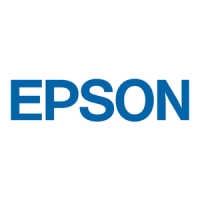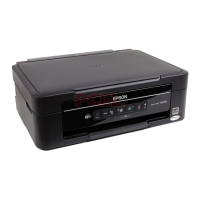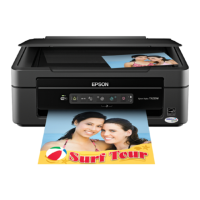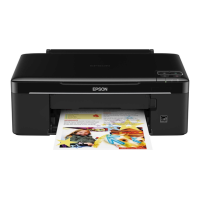Do you have a question about the Epson Stylus TX209 and is the answer not in the manual?
Precautionary statements for severe or fatal personal injury if ignored.
Precautionary statements for equipment damage if ignored.
Outlines the manual's structure, consisting of six chapters and an appendix.
Explains various symbols used in the manual for information and warnings.
Details available functions, high speed, high quality, and dimensions of the printers.
Lists printer specifications including print method, resolution, control code, and paper handling.
Lists printer specifications including print method, resolution, control code, and paper handling.
Provides product numbers for EPSON ink cartridges and storage information.
Details various print modes, resolutions, dot sizes, and borderless printing capabilities.
Lists paper types and sizes supported by the printer across different destinations.
Shows the printable area and margin specifications for standard and borderless printing.
Specifies the optical scanning range, resolution, and effective pixels for the scanner.
Specifies the optical scanning range, resolution, and effective pixels for the scanner.
Details primary power specifications, input voltage range, current, and power consumption modes.
Details primary power specifications, input voltage range, current, and power consumption modes.
Outlines operating and storage conditions for temperature, humidity, shock, and vibration.
Specifies the total print life, printhead life, and scanner carriage movement cycles.
Provides sound pressure levels for printing and scanning operations.
Lists safety and EMI compliance standards for various regions.
Describes specifications for USB device and host ports, including compatible standards and connectors.
Describes specifications for USB device and host ports, including compatible standards and connectors.
Lists supported memory card types, standards, maximum capacity, and remarks for direct printing.
Explains the functions of buttons and LEDs on the LCD-equipped CX8300/TX400 series control panel.
Explains the functions of buttons and LEDs on the LCD-equipped CX8300/TX400 series control panel.
Explains the buttons and LEDs on the CX7300/TX200 series control panel, which lacks an LCD.
Details control panel settings and their saving/initializing timing for CX8300/TX400 series modes.
Details control panel settings and their saving/initializing timing for CX8300/TX400 series modes.
Explains control panel buttons and LED functions for the CX7300/TX200 series without an LCD.
Explains conditions for entering and recovering from the control panel power saver mode.
Lists supported paper types and copy modes for CX8300/TX400 and CX7300/TX200 series.
Lists supported paper types and copy modes for CX8300/TX400 and CX7300/TX200 series.
Lists supported paper types and copy modes for CX8300/TX400 and CX7300/TX200 series.
Details the settable menu items for stand-alone copy functions on different models.
Illustrates the relationship between original document placement and copied output layout.
Provides copy speed specifications for different models and modes.
Lists paper types and print modes supported for memory card direct printing on different models.
Lists paper types and print modes supported for memory card direct printing on different models.
Describes supported file systems, media formats, and file types for memory card direct printing.
Explains how the printer automatically searches for and detects all images stored on an inserted memory card.
Details specifications for image size, maximum number of images, valid date/time, and file sorting.
Lists the menus and functions available in memory card mode for CX8300/TX400 series.
Explains how to print images from an index sheet by reading markings.
Explains print layout options and trimming function for direct printing.
Explains the trimming function for fitting images within photo frames during direct printing.
Describes how images are numbered and rotated based on photo frame layout and data orientation.
Lists DSCs compatible with USB Direct Print and PictBridge standards.
Lists DSCs compatible with USB Direct Print and PictBridge standards.
Details print settings that can be made directly from a connected DSC.
Outlines the common procedure for DSC direct printing, including printer and DSC settings.
Describes printer behavior and operations when a DSC is connected.
Details operations when the USB cable is connected or disconnected between the printer and DSC.
Lists supported paper types and print modes for the photo copy function.
Lists supported paper types and print modes for the photo copy function.
Details the menu items for the Reprint/Restore Photos function.
Explains how to properly place silver halide pictures on the document glass for scanning.
Describes how ink levels are displayed in a bar chart and related options.
Describes how ink levels are displayed in a bar chart and related options.
Explains how to print a nozzle check pattern to verify printhead nozzle status.
Details the process for running printhead cleaning to clear issues like clogged nozzles.
Explains the sequence for replacing ink cartridges through the menu or error prompts.
Allows users to adjust the brightness of the LCD screen.
Lets users select the layout for previewing images on the LCD.
Allows specifying print settings for camera direct print functions.
Details the procedure to ensure bi-directional print quality by adjusting printhead alignment.
Introduces the operating principles of the printer mechanism and electrical circuit boards.
Describes the printer mechanism components like carriage, paper loading, and ink system.
Lists and specifies the motors and sensors used in the printer and scanner mechanisms.
Explains the D4-CHIPS Turbo2 printhead, its configuration, and basic components.
Details the process of how the printhead fires ink drops from each nozzle.
Describes the variable dot mode for print quality and economy dot mode for fast printing.
Details the closed-loop control of the CR motor for carriage speed and position.
Details the closed-loop control of the CR motor for carriage speed and position.
Describes how the printer detects the carriage home position at power-on.
Explains the paper loading and feeding mechanism driven by the PF motor and PF encoder.
Details the paper loading mechanism involving the ASF unit, hopper, and change lever.
Describes the paper feed mechanism components and how they transport and eject paper.
Explains the components and functions of the ink system, including capping and carriage lock mechanisms.
Details the capping mechanism that covers the printhead to prevent ink evaporation.
Explains the carriage lock mechanism activated during capping operations.
Describes the wiping mechanism that cleans the printhead using the PF motor drive force.
Explains the pump unit mechanism driven by the PF motor to draw ink and send it to the waste ink pad.
Details initial ink charge, manual cleaning, timer cleaning, and flushing sequences.
Provides an overview of the scanner carriage unit, including CIS board, rod lens array, and LED.
Provides an overview of the scanner carriage unit, including CIS board, rod lens array, and LED.
Provides an overview of the scanner carriage unit, including CIS board, rod lens array, and LED.
Explains how the scanner carriage unit moves for image scanning and data processing.
Introduces how to solve problems with the printer.
Lists any specific tools required for troubleshooting the printer.
Outlines preliminary checks to ensure proper conditions before starting troubleshooting.
Provides troubleshooting steps for motors and sensors, including resistance and check points.
Provides troubleshooting steps for motors and sensors, including resistance and check points.
Explains how errors are indicated via LCD panel, EPSON Status Monitor 3, or LEDs.
Explains how errors are indicated via LCD panel, EPSON Status Monitor 3, or LEDs.
Provides troubleshooting procedures based on specific error messages or phenomena.
Addresses fault locations for print quality and abnormal noise issues not indicated by LEDs or STM3.
Introduces disassembly and reassembly procedures for printer components.
Lists crucial safety precautions to follow during disassembly and reassembly to prevent injury or damage.
Lists the specific tools recommended for disassembly and assembly to avoid damaging the printer.
Provides a checklist to verify proper completion of works and printer readiness after service.
Highlights differences in disassembly/reassembly for CX7300/TX200 series and CX8300/TX400 series models.
Presents a flowchart detailing the sequence of disassembly procedures for printer units.
Describes the procedure to remove the paper support assembly from the upper housing.
Describes the procedure to remove the paper support assembly from the upper housing.
Details the steps to remove the stacker assembly from the printer.
Provides instructions for removing the document cover and ASF cover.
Details the procedure for removing the scanner unit and its hinge.
Explains how to remove the upper housing and the card slot cover.
Details the steps to disconnect cables and remove the main board unit.
Details the steps to disconnect cables and remove the main board unit.
Provides procedures for removing the panel unit and LCD unit, noting model differences.
Details the procedure for disconnecting and removing the power supply unit.
Details the steps for unlocking the carriage and removing the printhead assembly.
Details the steps for unlocking the carriage and removing the printhead assembly.
Explains how to release and remove the CR scale from the printer mechanism.
Provides instructions for releasing the hopper and removing it with the compression spring.
Details the process of disconnecting cables and removing the printer mechanism (lower housing).
Explains how to remove the left frame of the printer.
Details the steps to remove the front and right frames of the printer.
Provides instructions for removing the star wheel holder assembly.
Details the procedure for removing the EJ roller and its associated spur gear.
Explains how to remove the PF encoder sensor.
Details the procedure for removing the PF scale secured by double-sided tape.
Provides steps for releasing the connector cable and removing the PF motor.
Details the procedure for releasing the motor cable and removing the CR motor.
Details the removal of extension springs, LD shaft holder, and main frame assembly.
Explains how to remove the CR scale holder and the CR unit itself.
Provides instructions for releasing hooks and removing the upper paper guide.
Details the steps for releasing the PE sensor cable and removing the ASF unit.
Explains how to detach the waste ink tube and remove the ink system unit.
Details the procedure for removing screws and releasing hooks to remove the front paper guide.
Provides instructions for removing the spur gear and the PF roller.
Explains how to remove waste ink pads, cover, and diffusion sheet.
Details how to remove the upper and front scanner housings.
Details how to remove the upper and front scanner housings.
Explains how to move and remove the scanner carriage unit.
Details the steps for removing the scanner motor unit.
Highlights differences in disassembly/reassembly for CX7300/TX200 series and CX8300/TX400 series models.
Explains the specific procedure for removing the panel unit on CX7300/TX200 series.
Introduces adjustments required after component replacement or repair.
Lists all servicing adjustment items, their purpose, method, and required tools.
Lists adjustments required based on specific parts repaired or replaced.
Guides users on judging adjustment patterns printed by the Adjustment Program.
Explains how to perform and judge the top margin adjustment pattern.
Details how to perform and judge the first dot position adjustment pattern for left margin correction.
Explains how to perform and judge head angular adjustment patterns for printhead tilt correction.
Details how to perform and judge Bi-D adjustment patterns for bi-directional print quality.
Explains how to perform and judge PF adjustment patterns for paper feed accuracy.
Explains how to perform and judge PF band adjustment for paper feed accuracy in band print mode.
Explains how to perform and judge bottom margin adjustment for borderless printing.
Provides information to maintain the printer in optimal condition.
Details cleaning procedures for exterior parts, interior, and specific rollers.
Guides on clearing "Maintenance request error" and performing printhead cleaning.
Details the type and amount of grease for lubricating printer parts when replaced or disassembled.
States that exploded diagrams or parts lists are not provided in this manual.











